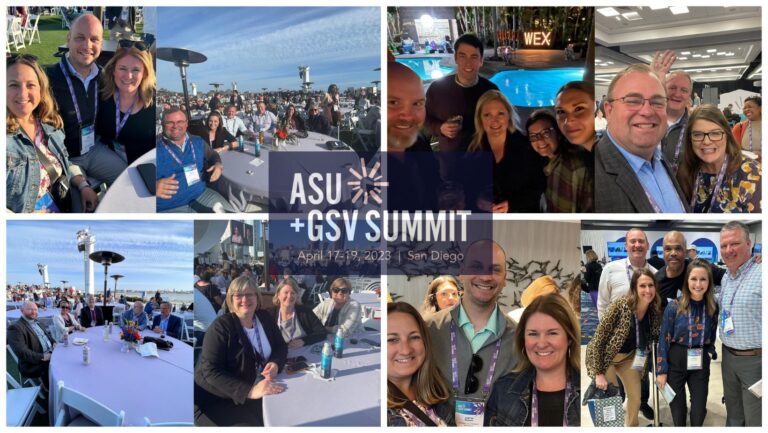A conversation about the 2023 ASU+GSV Summit
Moderated by Dr. Sarah Pazur
For the second year in a row, several Future of Learning Council members ventured to sunny San Diego for the annual ASU+GSV Summit which took place April 17-19, 2023. The Summit “connects leading minds focused on transforming society and business around learning and work,” and boasts an impressive lineup of speakers and thought leaders in education, technology, and business. I had the chance to catch up with five FLC members who shared their experiences at the conference along with their thoughts and plans for accelerating educational innovation in Michigan!
Dr. Sarah Pazur: Why did you want to attend the ASU+GSV conference?
Caitlin Stone-Webber: I am in a unique position to answer this question. Not only am I brand new to the world of education (year two with a degree in biology and a background in business), but I have also been tasked with starting a new program in our district melding alternative learning, online classes, and work placements/apprenticeships. We are just in year two of the program, so I am jumping at any opportunity for self-growth and networking. When I was approached about ASU+GVU, I was most excited about hearing how I could make my student’s relationship to tech more advantageous to them. It’s one thing to stick a learner in front of an online class and say go, but I want to really challenge them and give them the best opportunities for future success outside of the classroom. A tech conference of this scale gave me a great opportunity to see some of the options out there.
Ryan Bruder: For me, seeing the excitement of my superintendent and other FLC members after they attended ASU+GSV last year persuaded me to go. To hear the leadership team of FLC, a pretty forward-thinking, innovative organization, share that this conference challenged their thinking in new and different ways excited me to consider new possibilities.
Dr. David Richards: As a leader, I have always wanted to be constantly “futurescaping.” Meaning, I wanted to make sure that I was aware of what was on the horizon for learning in order for me to lead pro-actively. The opportunity to attend ASU+GSV was incredible as it gave me a chance to hear about innovations in learning that are happening around the world, not just in the US.
David Tebo: I wanted to attend for a number of reasons, the main one being my desire to look into the future and do what I can to be ahead of what’s coming to improve teaching and learning. I am driven by the possible and being strategic in setting the table for educational change.
Roman Stotland: This was my second year attending the conference and if there was only one conference I could attend a year I would choose ASU+GSV every time. The conference offers a very unique opportunity to see and connect with hundreds of EdTech startups and established organizations. Learn about the new and next when it comes to technology in education, and grow your network with top talent in the sector. I’ve always had a passion for utilizing technology in education and discovering new and innovative ways to do so and attending ASU+GSV has helped me see what that looks like on a global scale and bring a fraction of it back to my organization to incite curiosity and help move us forward.
Dr. Sarah Pazur: What sessions did you attend and what were some of your main takeaways?
Caitlin Stone-Webber: Since Ryan and Dave both discussed the AI content, I will bypass the information on that – it was certainly a huge component of the conference this year and I was able to attend a couple of sessions on it. I also had the opportunity to attend sessions on virtual internships, the progress of apprenticeships in education, and other business models being melded into education. I made it a point to attend a few sessions on SEL, one that stood out to me was with Brene Brown PHD, LMSW. She touched on the importance of putting the needs of the student first, saying, “All decisions in education should be based on the needs of children and not the convenience and comfort of adults.” It really stood out to me, and has since been taped to my workstation as a daily reminder for the things I don’t want to do. Another session I attended was “Getting Education While Incarcerated.” It was not only inspiring but eye-opening to see that every single person in that very full room was connected in some way to someone within the prison system. The two men speaking gave intentional and focused advice and ways for those working with students in the system to help them not only pursue an education, but to acquire and maintain a successful career on the other side of their time there.
Ryan Bruder: I went to a number of sessions about AI in the classroom and each one stretched my understanding and learning in so many ways. One of the best things I was able to do was go visit Cajon Valley Schools to see their World of Work. Considering some of their systems and structures and the values that drive those was inspiring. I was able to think about how we might be able to replicate some of their process with the work we are trying to do in our own district.
Dr. David Richards: Beyond the general sessions and panel discussions, my primary focus was on AI and attempting to network with foundations and investors. In the role I serve with the FLC, there is a growing need to identify resources that will allow us to scale our work for more districts across the state of Michigan. The ASU+GSV summit brings all of those that may be interested in supporting our work together in one location. It’s an ideal time to learn who strategic partners may be.
David Tebo: My main focuses were AI, tutoring and credentialing learning in new ways that will help devalue the GPA and standardized testing as the main measure of success for our learners. AI is going to significantly change how we work with kids in the next 6 – 24 months. Those teachers using it with students will be more effective than those who don’t. We have to be cognizant of the cultural impacts of the changes this will bring and be supportive of our teachers and learners. We are also able to start to create a more well rounded picture of our students in regards to things other than content knowledge. The issue will remain “how do we ensure that we are creating learning experiences that teach skills and help model habits?” so we can provide that feedback and create the opportunity for learner reflection.
Roman Stotland: This year the hot topic was around AI and many of the sessions I attended mentioned it even if it was not the main topic of that session. While I made a point to attend many of the AI sessions, they were mostly showcasing new tools and EdTech startups that utilized AI. The sessions I got the most out of talked about how AI has already influenced education and what the near future holds. It was really inspiring to listen to top talent that has worked with AI for many years, such as representatives from Google and IBM, and most of them saying the same thing, that change is coming quickly and we need to start thinking about ways to change education because AI is not a passing fad. The other sessions I found interesting were about the hot topic from last year, Web3. I was glad to see that it was not just a fad and that there was still a lot of really good work being done around utilizing Web3 technologies in education.
Dr. Sarah Pazur: How did the conference align to your personal and professional goals and values or to the work of the FLC?
Caitlin Stone-Webber: This is a really interesting time in education. We are at a point that technology is advancing faster than ever before, all while our mental health statistics are showing us that human connection is more important than it has ever been. Working in online alternative learning, with students whose barriers outweigh most, this has quickly become a focal point of mine professionally. This conference was a great opportunity to see the meld between these worlds. I came home feeling refreshed and with new starting points and avenues to try with our students.
Ryan Bruder: I hope that folks participating in FLC work walked away feeling inspired and validated. While many of the topics and technologies emphasized during the conference are new to many of us, the takeaways of the need, more than ever, to double-down on competency-based learning environments and an emphasis on the skills and qualities that make each of us, and our learners, uniquely human was everpresent during the conference.
Dr. David Richards: It is such a great fit for our work as an FLC because of the access it provides us to national and international education leaders. When you can hear directly from AI designers, Sal Kahn, and other creators of new learning models, it really gives you a snapshot for the future of learning. I always walk away challenged to keep pushing forward in this work. It’s mission-driven and it solidifies why the FLC has the opportunity to play an important role for our districts and schools in Michigan.
David Tebo: I came back with an enhanced vision of the future and a number of great connections to people and tools to support the future of learning. It affirmed that while I do push for change, the things that we have been working on and visioning are alive and well across the country and globally. We are behind in leveraging some of the tools and addressing culture, but we are poised to take great strides in the coming year, especially if we work together.
Roman Stotland: It really affirmed a lot of the work that I have been doing within my organization around exploring AI as well as other new and innovative technologies. It also gave me an opportunity to connect with FLC members and see firsthand how the experience of ASU+GSV influenced their thinking around technology and education. Personally it always reignites the passion within for the work that I do and provides many directions for growth to pursue after the conference.

Dr. Sarah Pazur: What overall takeaways did you bring back to your respective districts and organizations and how will you implement them in your practice moving forward?
Caitlin Stone-Webber: As a group from Michigan, we spoke at length about the promise of AI. I think the biggest take away was to come back with an open mind for the possibilities that come with the new technology. We have had quite a few conversations, both at work and in my own home, about the use of AI and how we can use it to advance our education without abusing it.
Ryan Bruder: In addition to what Caitlin shared, I started to think about AI in terms of a tool that has the potential to further support the work we are trying to do simultaneously working to address the misunderstandings and misconceptions of AI within our organizations.
Dr. David Richards: I came back, once again, with a healthy sense of urgency to do this work. There are so many large and small organizations that are laser-focused on creating a new model of school that our traditional public schools are completely unprepared for. Whether it is viewed as competition or choice, the reality is the learning landscape is changing dramatically and will be increasingly disruptive over the next 2-3 years. The impact of AI and the opportunities to create flexible learning models while maintaining a strong human connection will challenge every district leader, principal, and teacher. It’s not at a crisis level yet, but soon will be.
David Tebo: I have a deepened understanding of what AI is capable of, what it is, and how we might use it moving forward. I have been able to connect our team with a number of providers that are going to pilot projects with teachers in Ottawa County. I was blown away by how well this met and exceeded expectations.
Roman Stotland: One of the main takeaways was around building the understanding of what AI is and what it is not. Both within my organization and with our customers and partners. There was a lot of really good data presented at the conference on the use and exploration of AI tools and that there is a lot of room to grow when it comes to people trying out AI tools and doing so effectively. I really want to champion that work within my organization so that people get a better understanding of how these tools can be used and start coming up with new ways AI can support what they do.
Dr. Sarah Pazur: What advice do you have for FLC educators who are considering attending ASU+GSV?
Caitlin Stone-Webber: Take notes and debrief often. The sessions happen quickly and many times you’re sprinting from one to another to find seating, I have never seen anything like it! Talking through what you’ve learned with colleagues or new connections is a great way to solidify those things in your mind and to create a solid game plan for implementation at home.
Ryan Bruder: Most all of us know the feeling of mental exhaustion walking out of a really great meeting. It’s exhilarating, yet so tiring. This conference is back-to-back-to-back opportunities to sit in and participate in those meetings, so be sure to take care of yourself. Walk away for a few minutes. Consider how you might apply your new learning. What might be a takeaway or action step for your organization. At the same time, if you are lucky enough to go with a team, even better. The debriefs and conversations that follow are invaluable.
Dr. David Richards: We have been VERY fortunate for the team at Michigan Virtual for providing us with access to the registration scholarships from ASU+GSV. My advice to any leader would be, if you are offered the scholarship to attend, TAKE IT! You won’t regret the investment in time!
David Tebo: If you can get a scholarship, take advantage of it! Build in time to reflect and take notes, dream and sketch. Jump in and lean into the uncomfortable and then give yourself time to process and talk with people you trust and provide psychological safety so you move between comfort and uncomfortable. Dress business casual and wear comfortable shoes. Talk to anyone that inspires you, people are so open to talk, it’s different from other conferences.
Roman Stotland: Beyond wearing comfortable shoes (smile), understand that there is a lot to learn about and many sessions that you will want to attend but will not be able to because of scheduling or popularity. Take lots of notes, take pictures of the slides that show the presenters and their companies, make a list of questions for yourself and who you want to follow up with. All of that will give you much more to do after the conference itself. While at the conference, pick sessions well in advance but try to stay through the whole session instead of leaving early for the next one, it will give you an opportunity to connect with the presenters and grow your network. Lastly, take some time to debrief with those in your group, either asynchronously or throughout the conference, you will all learn something new and it helps to mentally walk through what you did that day.
| Dr. Sarah Pazur DIRECTOR OF SCHOOL LEADERSHIP AT CS PARTNERS | Caitlin Stone-Webber DIRECTOR OF ALTERNATIVE EDUCATION AND APPRENTICESHIPS, LAKER SCHOOLS | Ryan Bruder EXECUTIVE DIRECTOR OF INSTRUCTION, DEXTER COMMUNITY SCHOOLS |
| David Tebo DIRECTOR OF INNOVATION SERVICES, OTTAWA AREA ISD | Roman Stotand DIRECTOR OF TECHNOLOGY INTEGRATIONS, MICHIGAN VIRTUAL | Dr. David Richards EXECUTIVE LEARNING STRATEGIST, MICHIGAN VIRTUAL |



